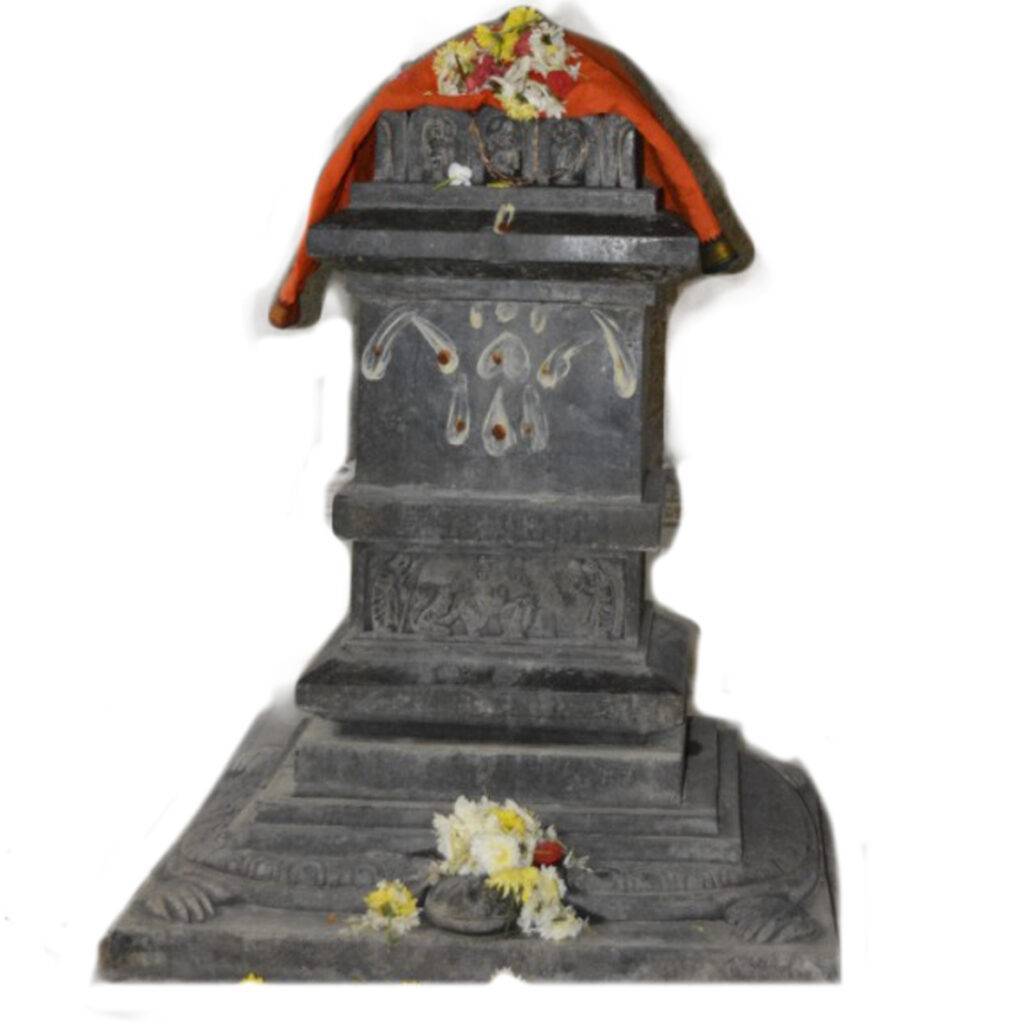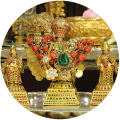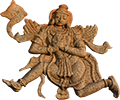Śrī Vidyāprasanna Tīrtha

Tenure : 1940 – 1969
Ārādhana : Mārgaśira pūrṇimā
Location : Sŏsale
Charama Shloka :
ಶ್ರೀಮತ್ಕೃಷ್ಣಪದಾಂಭೋಜಮಾನಸಂ ಕವಿಪುಂಗವಂ | ಶ್ರೀಮದ್ವಿದ್ಯಾಪ್ರಸನ್ನಾಬ್ಧಿಂ ಗುರುಂ ವಂದೇ ನಿರಂತರಂ ||
श्रीमत्कृष्णपदांभोजमानसं कविपुंगवम् | श्रीमद्विद्याप्रसन्नाब्धिं गुरुं वंदे निरंतरम् ||
śrīmatkṛṣṇapadāmbhojamānasaṃ kavipuṅgavam | śrīmadvidyāprasannābdhiṃ guruṃ vande nirantaram ||
About Śrī Vidyāprasanna Tīrtha
Śrī Vidyāprasanna Tīrtha was ordained the 37th Pīṭhadhpati by Śrī Vidyāvāridhi Tīrtha who himself was ordained by Śrī Vidyāratnākara Tīrtha.
Known as Ṭĕkkalūru Veṅkaṭanarasiṁhācārya in his Pūrvāśrama, he was the Pūrvāśrama Putra of Śrī Vidyāratnākara Tīrtha, whose Pūrvāśrama Nāma was Ṭĕkkalūru Āhobalācāryaru. Ṭĕkkalūrū is a small village near Coimbatore of TamilnAdu (https://en.wikipedia.org/wiki/Thekkalur). He was born on Kārtika Pūrnima (17-11-1899), a Friday on which Kṛttika Nakṣatra prevailed. He underwent both traditional schooling at home from his father and modern education (as desired by his mother). By 1924, he was a practising lawyer at Mysore. At the age of 36 in Yuva Nāma Saṁvatsara (1935 AD), he was called to adorn the Pīṭha from Śrī Vidyāvāridhi Tīrtha, since HH was slightly unwell and had decided on him to be the successo. He entered the Sanyāsāśarama on Āśvayuja Māsā, Śukla Pakśa, Śukravāra, during the navarAthri time at Sosale Kṣetra. However, Śrī Vidyāvāridhi Tīrtha recovered soon and continued his duties for five more years and Śrī Vidyāprasanna Tīrtha served as a junior pontiff during this time.
In 1940, Śrī Vidyāvāridhi Tīrtha was observing Cāturmāsya in Vikrama Nāma Saṁvatsara at Śrīraṅgam and entered Vṛndāvana on Bhādrapada Śukla Pancami – Ṛśi Pancami day. Śrī Vidyāprasanna Tīrtha then adorned the Pīṭha after completing the Mahāsamārādhana of His Gurugal̤u. He toured southern part of the countr, Karntaka, Tamil Nadu and Andhra Pradesh, extensively to bless followers of the Śrīmaṭha. We understand from tradition that HH spent most of His time at Vyāsarājapura (near Bannur) and composed hundreds of Devaranāmas with the Ānkita (pen-name) ‘Prasanna’, the shortened form of His Āśrama Nāma. The saint is known to have conducted Sabhās during important Ārādhanās, such as t Vyāsārāja and Śeṣa-chandrikācāryā’s, an example being the Daśapramati Darśana Prakāśini Sabha at which time Pandits from around the country were invited to participate in debates, deliver lectures, conduct Pāṭhā and were extensively honoured
It had been a long-time since the likes of Śrīpādarājaru, Vyāsarājaru and Vādirājaru that Devāranāmās were composed by Pīṭhādhipatis. This tradition was revived in our Śrīmaṭha during the times of Vidyākāntharu and then continued by Vidyāratnākararu and taken to glory by Vidyāprasannaru to the extent that the saint’s contribution can be branded as ‘Prasanna Sāhitya.’ While there is absolutely no difference in the content, it can be observed that HH’s style is unique, free-flowing and easily followable by the common man.
In addition, the saint also composed a lot of Spiritual plays, Nāṭaka on Ādhyātma Viśayagal̤u. From a historical perspective, he belonged to a time when the community at large treated drama, cinema and music as pastimes. His keen acumen was such that he used these three themes to take spirituality to the common man. He also translated the entire Sumadhva Vijaya to Kannada that went by the name Sumadhva Vijaya Sāra Sangraha. Similarly, he also composed a compendium that delineates appropriate behavioural practices at different times, Nīti Śāstra, as a reminder perhaps of His Pūrvāśrama Vṛtti (practising lawyer).
After around 34 years in the Sanyāsāśrama and sitting on the Pīṭha for 29 years, he anointed Śrī Pūrnabodhācārya to the fourth order Sanyāsāśrama with the name Śrī Vidyāpayonidhi Tīrtha and entered Vṛndāvana shortly afterwards on Mārgaśīrṣa Purṇima of Sŏumya Nāma Saṁvatsara at Sosale.
Observations by Pejāvara Śrīgal̤u (https://www.youtube.com/watch?v=BoL5k0_lrXE)
Pejāvara Śrīgal̤u recalled the long association he had with Vidyāprasannaru and mentioned that he cherished each moment of it. He indicated that the first meeting happened when he was about to start His first paryAya and was at BengalUru in 1951. At that time, Vidyāprasannaru invited Him to visit Sosale where they first met each other. Ever since, there was an extremely affectionate relationship that Śrīgal̤u likened to that between a father and son. Śrīgal̤u remembered the strong support that Vidyāprasannaru offered at the time of establishing Akhila Bharata Madhwa Mahamandali (ABMM) and the stellar role he played in its initial stages by participating and conducting all its activities, be it Vijayawada, Tirupati or anywhere else. Śrīgāl̤u fondly recalled that Vidyāprasannaru stood firm when there was an effort to rename ABMM and categorically stated that while everyone’s support is necessary, it is not essential for its sustenance. Śrīgāl̤u gratefully acknowledged the strength and support offered by Vidyāprasannaru toward the establishment of Pūrnaprajñya Vidyāpīṭha. Śrīgal̤u mentioned the unique contribution of Vidyāprasannaru to Dāsa Sāhitya and reminisced that His Devaranāmās were sung without fail at many locations where He had visited for Pādapūja. Śrīgal̤u also went back in history to mention an incident that demonstrates the conviction Vidyāprasannaru had on Sanātana Dharma. It was those peak days of opposition to Sanātana Dharma in Tamilnadu, a few decades back, when the environment was not conducive to practising Sanātana Dharma. In such a prevailing situation, Śṟīgal̤u was invited for a talk at a place called Chinnamanur (https://en.wikipedia.org/wiki/Chinnamanur) n the heart of Tamil Land. His talk turned out to be an extreme eye-opener that even his opposers greatly appreciated it and were inclined to revise their inappropriate understanding. Śrīgal̤u mentioned it is indeed appropriate that Śrī Vidyāśrīśaru, a well-known international authority on Vyāsatraya – Tarkatāṇḍava, Tātparya Candrikā and Nyāyāmruta is currently adorning the Pīṭha decorated by illustrious predecessors such as Vidyāratnākararu, Bhāśya Dīpikācāryaru, Seṣa Candrikācāryaru and the great Vyāsarājaru. Śrīgal̤u alluded to the famous allegory in Śāstraic parlance that Vidyāśrīśaru is indeed the full moon – Pūrnacandra that rose from the milk ocean Kṣīra Samudra that goes by the name Pūrnaprajñya Vidyāpīṭha to conclude the speech.


